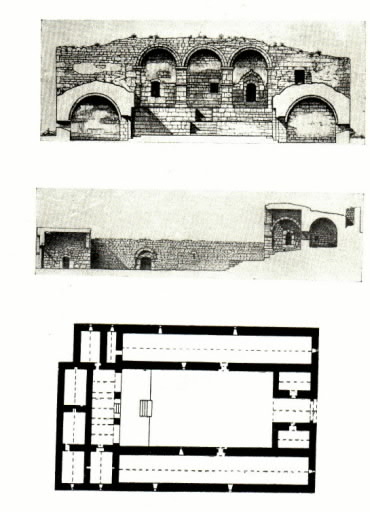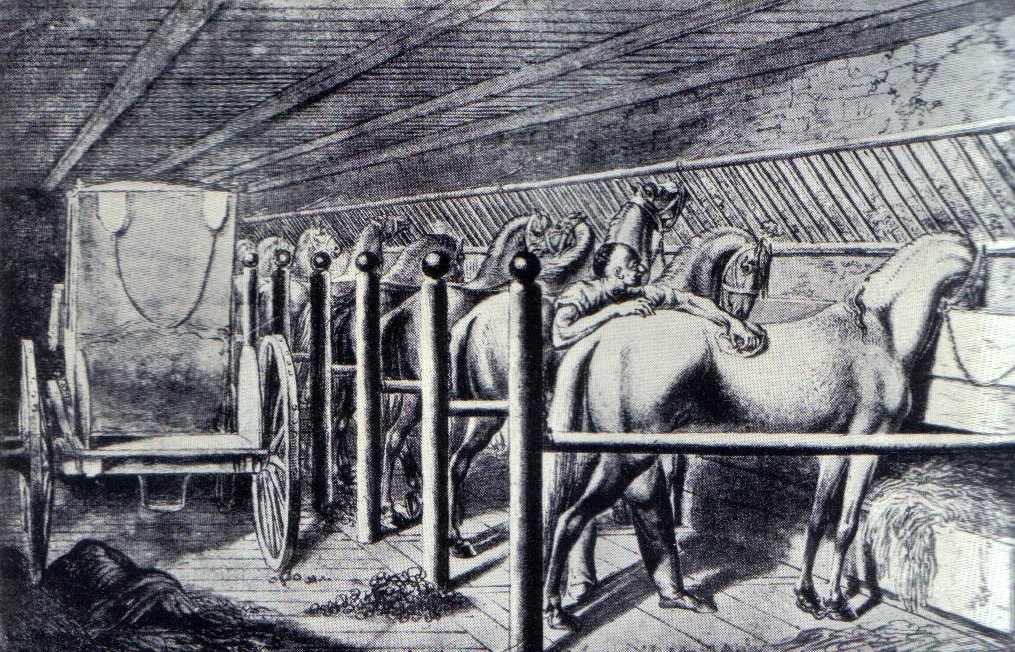|
Garghabazar Caravanserai
Garghabazar caravanserai ( az, Qarğabazar karvansarayı) is a historic monument of XVII century. It is located in Garghabazar village, of Fuzuli District, in Azerbaijan. History Sometimes referred as Shah Abbas caravansarai, the building dates from 1681 and it sits on a hill at Garghabazar village. The architect of the monument is unknown, since any inscriptions have been destroyed. After the occupation of Garghabazar village, the monument was ruined by Armenian forces. Architectural features According to its architectural style, Garghabazar caravanserai is similar to architectural traditions of Albanian period. The plan and architectural style of the caravanserai is made obedient to the general design by solving centered axis symmetrically. It consists of two large-sized camel stalls, two small rooms for guards on the right and left sides, 6 square-shaped rooms for caravanserai owner and merchants. The importance of these rooms is also reflected in the fact that they are ... [...More Info...] [...Related Items...] OR: [Wikipedia] [Google] [Baidu] |
Caravanserai
A caravanserai (or caravansary; ) was a roadside inn where travelers ( caravaners) could rest and recover from the day's journey. Caravanserais supported the flow of commerce, information and people across the network of trade routes covering Asia, North Africa and Southeast Europe, most notably the Silk Road. Often located along rural roads in the countryside, urban versions of caravanserais were also historically common in cities throughout the Islamic world, and were often called other names such as ''khan'', ''wikala'', or ''funduq''. Terms and etymology Caravanserai Caravanserai ( fa, کاروانسرای, ''kārvānsarāy''), is the Persian compound word variant combining ''kārvān'' " caravan" with ''-sarāy'' "palace", "building with enclosed courts". Here "caravan" means a group of traders, pilgrims or other travellers, engaged in long-distance travel. The word is also rendered as ''caravansary'', ''caravansaray'', ''caravanseray'', ''caravansara'', and ''caravansa ... [...More Info...] [...Related Items...] OR: [Wikipedia] [Google] [Baidu] |
Fuzuli District
Fuzuli District ( az, Füzuli rayonu) is one of the 66 districts of Azerbaijan. It is located in the south-west of the country and belongs to the Karabakh Economic Region. The district borders the districts of Khojavend, Aghjabadi, Beylagan, Jabrayil, and the Ardabil Province of Iran. Its capital is Fuzuli, however since the city is completely ruined following the First Nagorno-Karabakh War, the current ''de facto'' capital is Horadiz until Fuzuli is rebuilt. As of 2020, the district had a nominal population of 133,800. History The western half, including the capital, was controlled by the self-proclaimed Nagorno-Karabakh Republic, as a result of the First Nagorno-Karabakh War. Horadiz became the temporary administrative centre of Fuzuli District due to city of Fuzuli's occupation by Armenian forces on 23 August 1993. On October 17, 2020, most of the occupied portion of the district including the capital Fuzuli was announced to have been recaptured by Azerbaijan during ... [...More Info...] [...Related Items...] OR: [Wikipedia] [Google] [Baidu] |
Azerbaijan
Azerbaijan (, ; az, Azərbaycan ), officially the Republic of Azerbaijan, , also sometimes officially called the Azerbaijan Republic is a transcontinental country located at the boundary of Eastern Europe and Western Asia. It is a part of the South Caucasus region and is bounded by the Caspian Sea to the east, Russia (Republic of Dagestan) to the north, Georgia to the northwest, Armenia and Turkey to the west, and Iran to the south. Baku is the capital and largest city. The Azerbaijan Democratic Republic proclaimed its independence from the Transcaucasian Democratic Federative Republic in 1918 and became the first secular democratic Muslim-majority state. In 1920, the country was incorporated into the Soviet Union as the Azerbaijan SSR. The modern Republic of Azerbaijan proclaimed its independence on 30 August 1991, shortly before the dissolution of the Soviet Union in the same year. In September 1991, the ethnic Armenian majority of the Nagorno-Karabakh region formed the ... [...More Info...] [...Related Items...] OR: [Wikipedia] [Google] [Baidu] |
Qarğabazar, Fuzuli
Qarğabazar () is a village in the Fuzuli District of Azerbaijan. It is located in the southern part of Fuzuli city, at the foot of Ilanlidag Mountain (559,7 m), at a height of 460 meters. History The village was occupied by Armenian forces in 1993, during the First Nagorno-Karabakh War and all of its Azerbaijani inhabitants were forced out. Since 1993, the village was administrated as part of Hadrut Province of the breakaway Republic of Artsakh and renamed Ijevanatun (). On 20 October 2020 President of Azerbaijan The president of the Republic of Azerbaijan is the head of state of Azerbaijan. The Constitution states that the president is the embodiment of executive power, commander-in-chief, "representative of Azerbaijan in home and foreign policies", ... Ilham Aliyev announced that the village had been recaptured. Notable sites * Caravanserai built in 1681. * Giyas ad-Din Mosque, built in the 17th century. * There was a Russo-Tatar (Russo-Azerbaijani) primary sc ... [...More Info...] [...Related Items...] OR: [Wikipedia] [Google] [Baidu] |
Qarğabazar Karvansarasının Planı Və Kəsiyi
Kargabazar may refer to: * Haykashen, Armenia * Qarğabazar, Azerbaijan {{geodis ... [...More Info...] [...Related Items...] OR: [Wikipedia] [Google] [Baidu] |
Animal Stall
An animal stall is an enclosure housing one or a few animals. Stalls for animals can often be found wherever animals are kept: a horse stable is often a purpose-built and permanent structure. A farmer's barn may be subdivided into animal stalls or pens for cows and other livestock. Tie stalls are a type of stall where animals are tethered at the neck to their stall. It is mostly used in the dairy industry, although horses might also be stalled in tie stalls (often referred to as stands or straight stalls). Typical the barn has two rows of stalls, where the cow is tied up for resting, feeding, milking and watering. This type of housing is used in both regular and organic farming. Horse care In horse care, the standard dimensions for a "loose box" (UK) or "box stall" (US) vary from to , depending on local cultural traditions, the breed of horse, gender, and any special needs. Mares with foals often are kept in double stalls. Stallions, kept alone with less access to turnout, are ... [...More Info...] [...Related Items...] OR: [Wikipedia] [Google] [Baidu] |
Architecture Of Azerbaijan
Architecture is the art and technique of designing and building, as distinguished from the skills associated with construction. It is both the process and the product of sketching, conceiving, planning, designing, and constructing buildings or other structures. The term comes ; ; . Architectural works, in the material form of buildings, are often perceived as cultural symbols and as works of art. Historical civilizations are often identified with their surviving architectural achievements. The practice, which began in the prehistoric era, has been used as a way of expressing culture for civilizations on all seven continents. For this reason, architecture is considered to be a form of art. Texts on architecture have been written since ancient times. The earliest surviving text on architectural theories is the 1st century AD treatise '' De architectura'' by the Roman architect Vitruvius, according to whom a good building embodies , and (durability, utility, and beauty). Ce ... [...More Info...] [...Related Items...] OR: [Wikipedia] [Google] [Baidu] |
Caravanserais In Azerbaijan
A caravanserai (or caravansary; ) was a roadside inn where travelers ( caravaners) could rest and recover from the day's journey. Caravanserais supported the flow of commerce, information and people across the network of trade routes covering Asia, North Africa and Southeast Europe, most notably the Silk Road. Often located along rural roads in the countryside, urban versions of caravanserais were also historically common in cities throughout the Islamic world, and were often called other names such as ''khan'', ''wikala'', or ''funduq''. Terms and etymology Caravanserai Caravanserai ( fa, کاروانسرای, ''kārvānsarāy''), is the Persian compound word variant combining ''kārvān'' " caravan" with ''-sarāy'' "palace", "building with enclosed courts". Here "caravan" means a group of traders, pilgrims or other travellers, engaged in long-distance travel. The word is also rendered as ''caravansary'', ''caravansaray'', ''caravanseray'', ''caravansara'', and ''caravans ... [...More Info...] [...Related Items...] OR: [Wikipedia] [Google] [Baidu] |
Buildings And Structures Completed In The 15th Century
A building, or edifice, is an enclosed structure with a roof and walls standing more or less permanently in one place, such as a house or factory (although there's also portable buildings). Buildings come in a variety of sizes, shapes, and functions, and have been adapted throughout history for a wide number of factors, from building materials available, to weather conditions, land prices, ground conditions, specific uses, prestige, and aesthetic reasons. To better understand the term ''building'' compare the list of nonbuilding structures. Buildings serve several societal needs – primarily as shelter from weather, security, living space, privacy, to store belongings, and to comfortably live and work. A building as a shelter represents a physical division of the human habitat (a place of comfort and safety) and the ''outside'' (a place that at times may be harsh and harmful). Ever since the first cave paintings, buildings have also become objects or canvasses of much artistic ... [...More Info...] [...Related Items...] OR: [Wikipedia] [Google] [Baidu] |
Azerbaijani Culture
Azerbaijani culture may refer to: Regions *Culture of Azerbaijan The culture of Azerbaijan ( az, Azərbaycan mədəniyyəti) combines a diverse and heterogeneous set of elements which developed under the influence of Turkic, Iranic and Caucasian cultures. The country has a unique cuisine, literature, folk art, ... Ethnic groups * Azerbaijanis#Culture ** Iranian Azerbaijanis#Culture ** Azerbaijanis in Georgia#Culture {{disambiguation, geo ... [...More Info...] [...Related Items...] OR: [Wikipedia] [Google] [Baidu] |
Tourist Attractions In Baku
Tourism is travel for pleasure or business; also the theory and practice of touring, the business of attracting, accommodating, and entertaining tourists, and the business of operating tours. The World Tourism Organization defines tourism more generally, in terms which go "beyond the common perception of tourism as being limited to holiday activity only", as people "travelling to and staying in places outside their usual environment for not more than one consecutive year for leisure and not less than 24 hours, business and other purposes". Tourism can be domestic (within the traveller's own country) or international, and international tourism has both incoming and outgoing implications on a country's balance of payments. Tourism numbers declined as a result of a strong economic slowdown (the late-2000s recession) between the second half of 2008 and the end of 2009, and in consequence of the outbreak of the 2009 H1N1 influenza virus, but slowly recovered until the COVID-1 ... [...More Info...] [...Related Items...] OR: [Wikipedia] [Google] [Baidu] |







